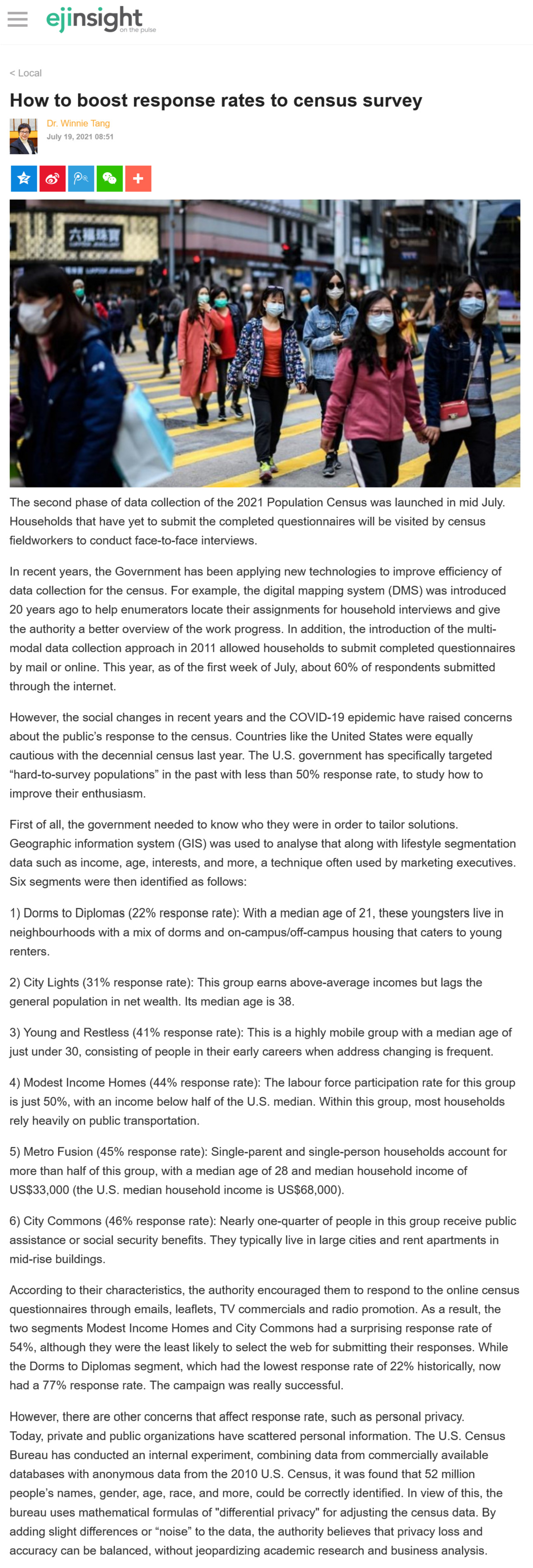網上版請按此

How to boost response rates to census survey
The second phase of data collection of the 2021 Population Census was launched in mid July. Households that have yet to submit the completed questionnaires will be visited by census fieldworkers to conduct face-to-face interviews.
In recent years, the Government has been applying new technologies to improve efficiency of data collection for the census. For example, the digital mapping system (DMS) was introduced 20 years ago to help enumerators locate their assignments for household interviews and give the authority a better overview of the work progress. In addition, the introduction of the multi-modal data collection approach in 2011 allowed households to submit completed questionnaires by mail or online. This year, as of the first week of July, about 60% of respondents submitted through the internet.
However, the social changes in recent years and the COVID-19 epidemic have raised concerns about the public's response to the census. Countries like the United States were equally cautious with the decennial census last year. The U.S. government has specifically targeted "hard-to-survey populations" in the past with less than 50% response rate, to study how to improve their enthusiasm.
First of all, the government needed to know who they were in order to tailor solutions. Geographic information system (GIS) was used to analyse that along with lifestyle segmentation data such as income, age, interests, and more, a technique often used by marketing executives. Six segments were then identified as follows:
1) Dorms to Diplomas (22% response rate): With a median age of 21, these youngsters live in neighbourhoods with a mix of dorms and on-campus/off-campus housing that caters to young renters.
2) City Lights (31% response rate): This group earns above-average incomes but lags the general population in net wealth. Its median age is 38.
3) Young and Restless (41% response rate): This is a highly mobile group with a median age of just under 30, consisting of people in their early careers when address changing is frequent.
4) Modest Income Homes (44% response rate): The labour force participation rate for this group is just 50%, with an income below half of the U.S. median. Within this group, most households rely heavily on public transportation.
5) Metro Fusion (45% response rate): Single-parent and single-person households account for more than half of this group, with a median age of 28 and median household income of US$33,000 (the U.S. median household income is US$68,000).
6) City Commons (46% response rate): Nearly one-quarter of people in this group receive public assistance or social security benefits. They typically live in large cities and rent apartments in mid-rise buildings.
According to their characteristics, the authority encouraged them to respond to the online census questionnaires through emails, leaflets, TV commercials and radio promotion. As a result, the two segments Modest Income Homes and City Commons had a surprising response rate of 54%, although they were the least likely to select the web for submitting their responses. While the Dorms to Diplomas segment, which had the lowest response rate of 22% historically, now had a 77% response rate. The campaign was really successful.
However, there are other concerns that affect response rate, such as personal privacy.
Today, private and public organizations have scattered personal information. The U.S. Census Bureau has conducted an internal experiment, combining data from commercially available databases with anonymous data from the 2010 U.S. Census, it was found that 52 million people's names, gender, age, race, and more, could be correctly identified. In view of this, the bureau uses mathematical formulas of "differential privacy" for adjusting the census data. By adding slight differences or "noise" to the data, the authority believes that privacy loss and accuracy can be balanced, without jeopardizing academic research and business analysis.
Dr. Winnie Tang
Adjunct Professor, Department of Computer Science, Faculty of Engineering; Department of Geography, Faculty of Social Sciences; and Faculty of Architecture, The University of Hong Kong